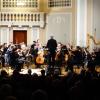
The Mission Chamber Orchestra of San Jose (MCOSJ) has been subsisting on guest conductors this season, following the retirement of its founding music director, Emily Ray. The group’s season’s finale on May 11 was led by Anthony Rivera, music director of the orchestra at Santa Clara University. The concert was held at Shannon Theatre, the small auditorium of Fremont High School in Sunnyvale, facilitating the participation of members of the FHS Chamber Orchestra.
Members of this group joined some of the MCOSJ musicians for the first work on the program, Caroline Shaw’s Entr’acte for string orchestra. This piece’s whimsical combination of rich conventional harmony and wobbly, breathy compositional tricks made it sometimes difficult to tell when the music was going deliberately adrift from its harmonic base and when the musicians were having difficulty accomplishing this effect. Still, it was an emotionally successful rendition, combining hesitancy at some points with firm drive at others.
The full MCOSJ strings played selections from Dancing With J.S. Bach, Eric Nathan’s imaginative orchestration of movements — not necessarily dances — from Bach’s keyboard suites.
The strings were then joined by winds and horns — and principal oboe Robert Scott as soloist — in Jean Françaix’s charming neoclassical concerto L’horloge de flore (Flower clock). The piece’s seven brief movements depict flowers blooming at different times of day. Scott began with a strong tone and snappy legato, reaching a climax halfway through with the catchy tune in the “Malabar Jasmine” movement, but after that he began having intonation problems with his instrument. Overall, though, the performers put the work across well, with plenty of witty exchanges between Scott and the other instrumentalists.
After intermission, the full orchestra tackled Jean Sibelius’s largest symphony, No. 2 in D Major. This was a huge bite for a small chamber orchestra to chew on, and they did not always swallow it fully. Ensemble and intonation were often sketchy, especially in the faster movements. In the transition between the scherzo and the Finale, the ensemble completely fell apart, yet the general thrust of the music proceeded triumphantly. That contrast characterized the whole performance: Despite imperfections in playing, it was gratifyingly pleasant to listen to. The Andante was particularly moving, grand and serious with determination that plowed through the slow tempo.
The Finale is the most difficult movement of Sibelius’s Second. The challenge of this movement is it keeps sounding as if it’s about to end long before it does, and this problem was not entirely solved on Saturday. That did not prevent Rivera and the players from proceeding through the movement with energy and enthusiasm. For the actual ending, the orchestra effectively gathered itself together for the further emphasis that this passage needs if the work is going to arrive at a satisfactory conclusion. The brass instruments particularly shone here.
A tiny prelude concert by the FHS Chamber Orchestra, 15 minutes before the concert’s announced starting time, greeted concertgoers who were fortunate enough to arrive early. Joseph Kelly, Fremont music teacher and orchestra director, led 16 string players and an electronic keyboard player in movements from Samuel Adler’s Concertino No. 1 for String Orchestra, crunchy tonal neoclassicism in a style akin to Ernest Bloch, and Soo Han’s slow and somber Song for UhmMa. Then, without a conductor, the players stood and gave a rousing rendition of Dmitri Shostakovich’s Waltz No. 2 from the Suite for Variety Orchestra, as arranged for strings by Paul Lavender.



